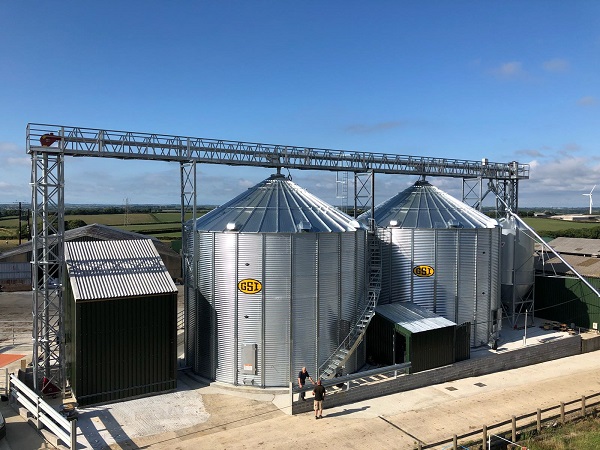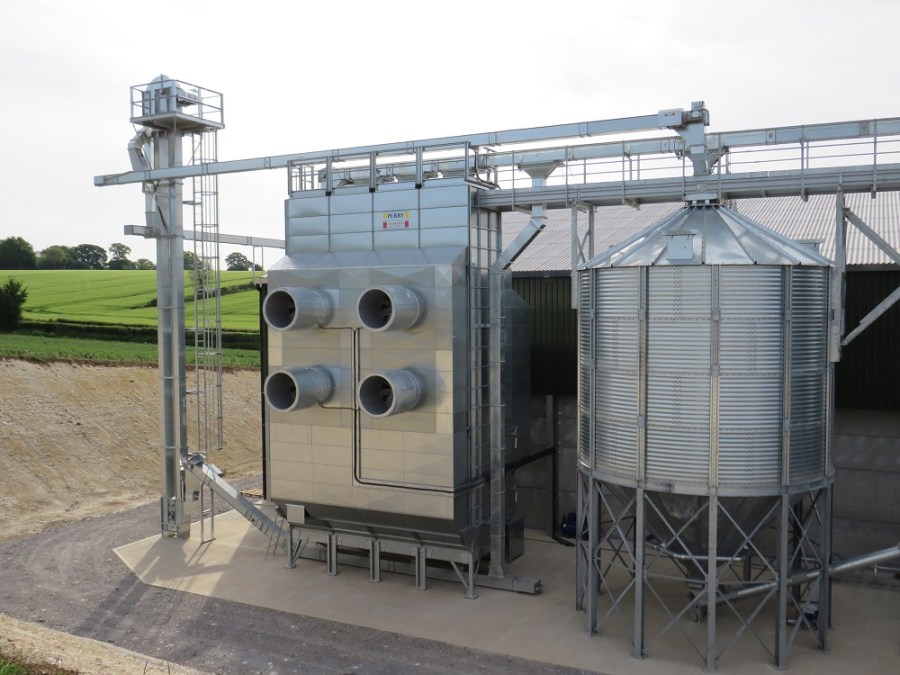Getting a crop to harvest is enough of a challenge for growers, but for those drying and storing their own grain, the story doesn’t end with the combine. CPM takes a look at grain stores and gadgets to make the process work for you.
The systems work with a huge amount of data, but the app will just supply the farmer with what they need or want to know.
By Melanie Jenkins
When operating a grain store, there’s a lot to think about; from grain movement to drying, moisture testing and system controls. So what options are out there to maximise grain quality with minimal input?
Danagri-3S
While grain store design hasn’t changed much in recent years, it’s all about adopting the most efficient system for your farm. Danagri-3S specialises in silos, with most sales in the UK from 250-1000t.
“With these, there’s the option to include an in-bin stirring machine which evens out the moisture content,” explains the firm’s Mark Unitt. Using this system, either an ambient or gas heater can take the moisture content of feed wheat down by 2% throughout the whole bin within 24 hours. “If you need a slower drying rate for milling wheat, malting barley or oilseed rape, it can usually reduce moisture content by 0.5-1% per day,” he explains.

As contained systems, grain is inaccessible to pests in the Danagri 3S silo.
As a contained system, grain is inaccessible to pests, and in the winter, cold air can be vented through to reduce the risk of mycotoxins building up, he adds.
When it comes to filling the bin, you can either use an auger or install an intake pit, speeding up harvest operations, says Mark. There are options of above-floor pits, level-floor pits or a dry pit system.
Above-floor pits comprise a hopper – from 1m to 10m wide – and are designed for trailers to back up to and dump into. Conveyors with capacities from 25-150 t/hr then transport grain to the silo.
Level-floor pits are becoming increasingly popular where underfloor pits can’t be used due to water table restrictions. The top of the intake conveyor is placed at floor height and can be 12-30m in length according to its strength and capacity. This enables farmers to put in a large enough pit to accept a full trailer or lorryload. The conveyor then empties the pit and can be turned off via a sensor when it’s empty.
The latest pit system is a dry pit from JEMA. This is a modular build, sunken intake pit designed to avoid water ingress and allow for conveyor servicing. It’s bolted together, sunk into a vertical concrete pit and then the edges are filled in with cement so there are no horizontal surfaces. The dry pit system fits with the JEMA chain and flight conveyors T45, T49 and T57 and capacities range from 12.7-48.3m3.
“When it comes to emptying the silo, Dangari-3S has a simple sweep auger machine which is carried into the silo once the grain has reached its angle of repose,” explains Mark. “It then circulates and drops down within the remaining grain and augers back to the centre sump leaving only a simple manual sweep-up operation.”
A more popular method, and the latest trend in bin emptying, he says, is for a direct drive Powersweep system to be fitted in the bin. Remaining in the bin at all times it’s operated by an electric motor on the external power head. These sweeps are available in 6″, 8″ and 10″ diameter for unloading speeds up to about 80 tonnes/hr.
In the next year, Danagri-3S is looking to update its electronic systems to ease the flow of information to the farmer. “This will make data on grain more accessible and automate moisture readings using sensors,” explains Mark.
BDC Systems
BDC Systems has developed an automatic sampling unit that can supply farmers with moisture content readings as grain passes through the dryer.
It takes samples from the incoming wet grain and outgoing dry elevators, which it processes through a multi-chamber duct incorporating a Sinar moisture probe specifically designed for this application.
Live readings showing the moisture content of both samples are displayed on a screen along with a graph showing the moisture trend, while historical data is stored for future reference. It can also be linked to BDS’s control panel and data can be viewed remotely. “This information can be used to adjust dryer settings which will save money and ensure grain goes into storage at its optimum moisture content,” says Matt Graine of BDC. “The ultimate aim is to automate the entire process.”
Perry of Oakley
Perry of Oakley’s PLC dryer control panel puts connectivity in the farmer’s hands, using a 12-inch touch screen to regulate handling and the dryer operations. The system can send over 70 alarms and messages relating to the dryer status, with all data logged for farm records.
The operator can enter crop type, intake moisture content and target moisture content, and the panel then sets up the dryer parameters, with temperature and fan speed set to suit crop type.
The auto discharge control system uses a list of adjustable parameters – including the sensitivity, rate of sampling and target hot grain temperature – alongside the exhaust air temperature – to control the process and maintain a consistent moisture content of the discharged grain.
The panel can also provide automatic moisture control, which monitors the top and bottom of the dryer to detect incoming and outgoing moisture changes, thereby controlling the discharge speed accordingly. According to Perry of Oakley, the sensor is accurate to 0.5% between 5% and 18% moisture content and within 1% between 18% and 40%. Though it’s fully integrated with the PLC control software, it can also be installed with any make of existing drier or standalone system.
Mobile phone app technology has finally made its way to the grain store with Perry of Oakley’s app allowing farmers to view the plant control panel and have full remote control of the dryer from any smartphone or computer.
When it comes to physical grain drying, Perry’s Savannah series features fans which are controlled by an inverter, meaning there could be potential to save power and crop lift off by running the fans at a reduced speed. The fan selection has been revised on previous models to reduce overall power consumption, giving a maximum fitted power of 22kW per fan.
The drier has been built with a 2mm thick grain column for additional strength and longevity, while the top ducts are 3mm thick to prevent deformation and wear.
For handling very wet grain, the dryers are all fitted with Perry’s pneumatically controlled Shutter discharge to keep grain moving down the column.
Farmex
Farmex is soon to replace its process controller, Dicam, with an upgraded model. Used to regulate any process involving sensors, actuators, fans, heaters and beyond, the firm claims the product has a strong track record in crop storage facilities. “It was built as a flexible agricultural control unit, so there’s no limit to what sort of sensors can be connected to it and there’s no restraint to the capacity of the load,” explains Hugh Crabtree of Farmex. Sensors can be used in read- and display-only mode or used as a function of process control.
Dicam 2 is due for commercial release in 2020. It has been constructed to peer-to-peer network, meaning it can connect with other systems like itself, total flexibility regarding sensors and what it can control. However its processing and memory are more powerful so iIt has many more connectivity options. This means it can connect to other systems on the farm and could become the data capture platform for the whole site, says Hugh.
One of the main changes that end users will see is that access to the system is available via a new mobile app. “Instead of going to the unit to change the settings, these can all be done remotely, as long as there’s network connectivity,” he adds.
Through the app, users will have access to full functionality of their dryer, and will also be able to use a limited range of data analysis tools. The unit collects an in-depth range of data, but further analysis and subsequent access are granted through a subscription service, so the farmer can tailor access to their needs. “The systems work with a huge amount of data, but the app will just supply the farmer with what they need or want to know.”




